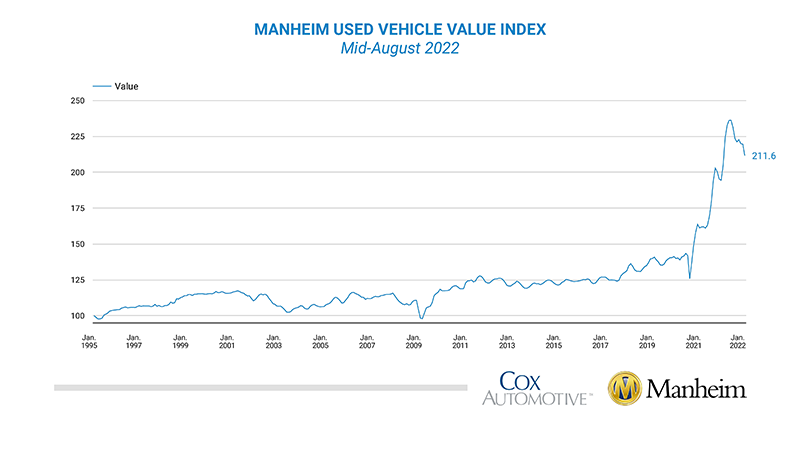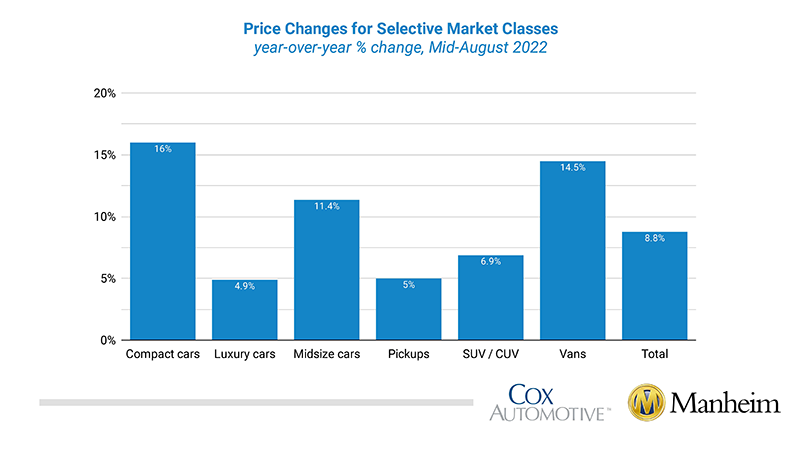While down from the peak in May, prices are up nearly 9% over August 2021.
Wholesale used-vehicle prices, on a mix-, mileage-, and seasonally adjusted basis, declined 3.6% from July in the first 15 days of August. The Manheim Used Vehicle Value Index fell to 211.6, which was up 8.8% from August 2021. The non-adjusted price change in the first half of August was a decline of 2.0% compared to July, leaving the unadjusted average price up 6.6% year over year.
Generally, lower used vehicle prices increase pressure on the number of total losses impacting the collision repair industry, while rising prices allow for more collision repair work to be performed prior to a vehicle being declared a total loss.
Over the last two weeks, Manheim Market Report (MMR) prices saw higher-than-normal and consistent declines resulting in a 1.2% cumulative decline in the Three-Year-Old MMR Index, which represents the largest model-year cohort at auction.
Over the first 15 days of August, MMR Retention, which is the average difference in price relative to current MMR, averaged 98.2%, which indicates that valuation models are ahead of market prices. The average daily sales conversion rate of 51.3% in the first half of August increased relative to July’s daily average of 46.8% but remains lower than the typical conversion rate this time of year. The latest trends in key indicators suggest wholesale used-vehicle values should see declines in the second half of the month.
All major market segments saw seasonally adjusted prices that were higher year over year in the first half of August. Vans had the largest increase at 14.5%, while both non-luxury car segments again outpaced the overall industry in seasonally adjusted year-over-year gains. Compared to July, all major segments saw price declines, with SUVs and pickups down the most and vans and compact cars down the least. The seasonal adjustment amplified the declines, but all major segments saw unadjusted price declines in the first 15 days of August.
Retail and wholesale days’ supply elevated in mid-August. Using estimates based on vAuto data as of August 15, used retail days’ supply was 47 days, which was down four days from the end of July. Days’ supply was up eight days year over year and up two days against the same week in 2019. Leveraging Manheim sales and inventory data, we estimate that wholesale supply ended July at 31 days, up five days from the end of June and up nine days year over year. As of Aug. 15, wholesale supply was at 30 days, down one day from the end of July and up eight days year over year and five days higher than 2019. Higher than normal days’ supply indicates conditions that favor buyers over sellers.
Consumer Sentiment Impact on Sales
The initial August reading on Consumer Sentiment from the University of Michigan increased 7% to 55.1 across the U.S. The increase was from improving future expectations as the view of current conditions declined. The main worry in the data was the expected inflation rate in five years increased to 3.0% from 2.9% in July, but consumers’ expectation of inflation over the next year fell to 5% from 5.2% in July.
Consumers’ views of buying conditions for vehicles declined as views of both prices and interest rates deteriorated. The only prior times consumers felt worse about auto loan interest rates than they do now was in 1980–1982, when rates were much higher. The daily index of consumer sentiment from Morning Consult increased 4.9% in the first 15 days of August. The index has improved as gas prices have been falling. The average price of unleaded nationally was $3.95 on Monday, which was down 21% from the peak in June.

